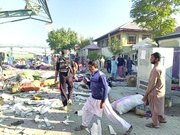Groundwater extraction in connection with urbanization and population growth is the main cause of severe land subsidence in mega-cities.
Based on the latest studies, around half of plains nationwide are at the risk of deforestation. This issue has led to land subsidence of more than 54 centimeters in some parts of the country, as much as 140 times the globally accepted rate of 4 millimeters per year.
The sinking might be irreversible
Tehran is the most populous city in West Asia, and it's sinking into the ground at an alarming rate.
The metropolis is home to some 15 million people and is a victim of dramatic subsidence. New research reveals that the region is sinking by more than 25 centimeters annually in some parts.
Environmentalist, Mohammad Darvish, has said that the drought situation over the past couple of years in the country has exacerbated land subsidence. “The subsided lands will not be back to their normal state and the only work we can do is to prevent it from getting worse.”
“This year, in addition to precipitations, the coronavirus outbreak also helped the nature and its biodiversity to improve resilience, but thee all are just somehow temporary pacifiers. Unfortunately, wildfires at forests are growing at an unprecedented rate and this is very worrisome for the country which only seven percent of its area is covered by forests.”
Groundwater exploitation, the main culprit
According to a study carried out by the Transport, Housing, and Urban Development Research Center, some 18 densely populated provinces are vastly subsiding and consequently, become increasingly vulnerable to flooding and natural incidents as well as bearing huge infrastructure damage.
Over the past decades, groundwater exploitation has increased dramatically due to permanent droughts, leading to aquifer depletion.
Inefficient irrigation methods in addition to digging illegal wells are the other main causes of groundwater extraction-induced subsidence, according to the study.
All in all, government authorities and local people often fail to realize that falling land levels are an urgent problem. A different mindset and an integrated approach are required to stop the trend.
First published in Tehran Times daily




















Your Comment